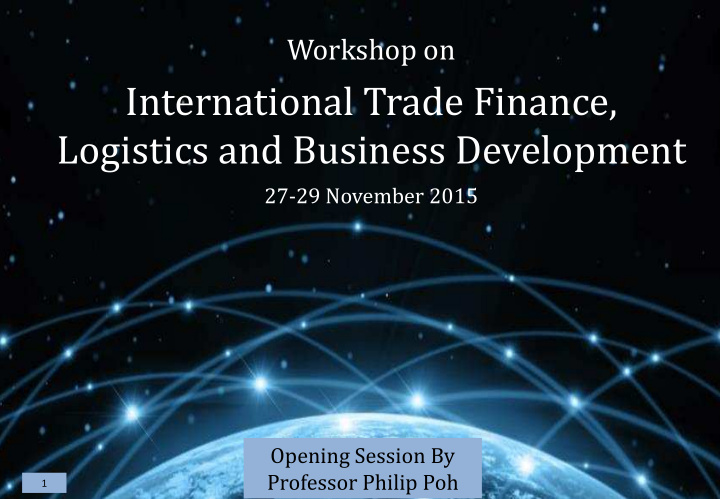



Workshop on International Trade Finance, Logistics and Business Development 27-29 November 2015 Opening Session By Professor Philip Poh 1
A Brief Backdrop of Myanmar Myanmar became an independent nation in 1948 Following a military coup in 1962, Myanmar was ruled by a military government until 2011. In 2011, the military junta was officially dissolved after the 2010 general election and a nominally civilian government was installed. With the release of political prisoners, Myanmar has improved the country’s human rights record and foreign relations. This has led to the easing of trade and other economic sanctions. References: IMF, World Bank, ITC, WTO, May 2015 2
Opportunities and Challenges Myanmar is a country rich in jade and gems, oil, natural gas and other mineral resources. But the country is currently one of the poorest in Asia and faces many challenges. Myanmar joined ASEAN in 1997. Today Myanmar shows good potential for inclusive growth, after having emerged from 5 decades of economic and political isolation. According to Asian Development Bank (2015), Myanmar could be the next rising star in Asia if it can leverage its rich endowment of resources. References: Asian Development Bank, May 2015 3
Population & GDP for ASEAN nations 2014 S/N Country Population GDP in $millions 1 Indonesia 4 252,812,245 16 888,538 2 Philippines 12 100,096,496 40 284,582 3 Vietnam 14 92,547,959 55 186,205 4 Thailand 20 67,222,972 32 373,804 5 Myanmar 24 53,718,958 71 64,330 6 Malaysia 43 30,187,896 35 326,933 7 Cambodia 69 15,408,270 115 16,709 8 Laos 106 6,894,098 135 11,772 9 Singapore 114 5,517,102 36 307,872 10 Brunei 175 423,205 112 17,257 References: IMF, World Bank, ITC, WTO, 2015 4
Myanmar’s Main Merchandise Exports S/N Commodity Group % Share 1 Fuels and mining products 43.8% 2 Manufactured products 29.5% 3 Agricultural products 26.5% Others 0.2% Total Exports of US$11,031 million in 2014 100% 5 References: World Trade Organization 2015
Myanmar’s Main Merchandise Export Destination S/N Country % Share 1 Thailand 41.7% 2 Hong Kong 21.1% 3 India 12.6% 4 China 6.2% 5 Singapore 3.6% Others 14.8% Total Exports of US$11,031 million in 2014 100% References: World Trade Organization 2015 6
Myanmar’s Commercial Services Exports S/N Commodity Group % Share 1 Travel 42.1% 2 Goods-related services 16.8% 3 Transportation 10.6% Others 30.5% Total Exports of US$2,204 million in 2014 100% 7 References: World Trade Organization 2015
Myanmar’s Main Merchandise Imports S/N Commodity Group % Share 1 Manufactured products 67.9% 2 Fuels and mining products 17.3% 3 Agricultural products 5.1% Others 19.9% Total Imports of US$16,226 million in 2014 100% 8 References: World Trade Organization 2015
Myanmar’s Main Merchandise Imports Origin S/N Country % Share 1 China 27.1% 2 Singapore 27.0% 3 Thailand 11.4% 4 Korea 6.1% 5 Japan 5.3% Others 23.1% Total Imports of US$16,226 million in 2014 100% References: World Trade Organization 2015 9
Myanmar’s Commercial Services Imports S/N Commodity Group % Share 1 Transportation 57.7% 2 Travel 7.9% 3 Other commercial services 34.4% Total Imports of US$1,456 million in 2014 100% 10 References: World Trade Organization 2015
Key Strengths & Opportunities Large youthful population, that can provide an attractive labor force for foreign investment. Rich supply of natural resources and inputs for agricultural development. Potential of renewable energy, notably hydropower. Investment opportunities in a range of sectors, including tourism and telecommunications. Strategic geographic location between the region’s emerging giants and able to benefit from Asia’s integration. References: Asian Development Bank, May 2015 11
Key Topics covered Trade Financing & Foreign Exchange Rules Trade Facilitation and SME Link Platform Uniform Rules on Demand Guarantees and for Bank Payment Obligation International Trade Documentations & 2010 Incoterms New International Standard Banking Practice UN TIR Convention (Transports Internationaux Routiers – International Road Transports) Myanmar Business Survey Analysis and Recommendation. 12
Thank you for your Attention Session By Professor Poh 13
Recommend
More recommend